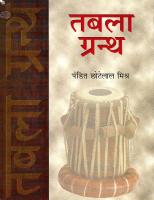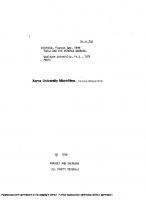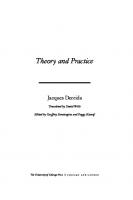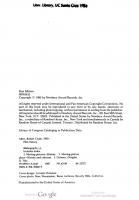Theory and Practice of Tabla 8179911497
812 140 14MB
English Pages 239 [126] Year 2005
Cover
Foreword/Preface
Contents
Part I
Manifestation of Laya
The Evolution of Rhythmic Instruments
The Genesis of Tabla
The Alphabets and Learning of Tabla
Taal Shaastra and Time Management
“Dasha Praan” or 10 Salient Features of Taal
Gharanas
Riyaaz
Solo Tabla Recital
Accompaniment
Scripts Used for the Learning of Tabla
Terminology – Definition, Meaning and Description
Biographies of Eminent Tabla Players
Biographies of Pakhawajis
Part II
Key to Reading of Tabla Bols
Taal Dadra
Taal Teental
Taal Roopak
Taal Jhaptaal
Taal Adachoutaal
Taal Ektaal
Shankh Taal
Taal Pancham Savaari
Vasant Taal
Taal : Asht’mangal
Bibliography
Index
Recommend Papers

- Author / Uploaded
- Sadanand Naimpalli
File loading please wait...
Citation preview
THEORY AND PRACTICE OF TABLA SADANAND NAIMPALLI
POPULARPRAKASHANPVT. LTD. 35-C, Pt. Madan Mohan Malaviya Marg Popular Press Building, Tardeo Mumbai 400 034 Shop online at www.popularprakashan.com
© 2005 Sadanand Naimpalli
First Published 2005 'ISBN 81-7991-149-7 (3897)
Pandit Taranath Rao Hattiangadi (15-03-1915 to 10-01-1991)
Typeset & Designed by Vans Information Ltd. 35-C, Pt. Madan Mohan Malaviya Marg Popular Press Building, Tardeo Mumbai 400 034
Printed in India by Tarun Enterprises 20, Jaina building Roshan Ara Road, Delhi 110 007
Published by Ramdas Bhatkal for Popular Prakashan Pvt. Ltd. 35-C, Pt. Madan Mohan Malaviya Marg Popular Press Building, Tardeo Mumbai 400 034
When I came to you as a toddler, you held my little hand, taught me Tabla and led me through a maze of worldly experiences. Even today, in times of crises, I can feel your presence by me, guiding me, egging me on when I am about to give up. Whenever I sit for my Riyaaz or participate in concerts, I can feel your strong vibrations course through my being. For me, meeting you and being under your loving care and tutelage was by itself the greatest fulfillment of my life. That in the process, I got to learn the art of Tabla playing has been a bonus. I am trying my level best to repay my debt of gratitude to you by teaching my young shishyas the Tabla you so lovingly handed down to me. I can feel the shortcomings in me - painfully. But then, I take solace from pie fact you were the Fountainhead and me but a drop of that water. With deepest humility, as a token of my unabashed admiration for you and unstinted devotion to your ideals, I dedicate this book to your hallowed memory and pray to God - nay to Thee, to inspire me to continue on the path you have shown. JAi GURU!
iii
FOREWORD One of the main concerns I have is about the lack of unification in the standardization of the teachings of tabla. Tabla is one of the youngest instruments in the field of North Indian Classical music and is still in the development stage. But the repertoire that is played on tabla is a mix of the pakhawaj compositions of the old tradition and compositions that have been recently written for tabla. By recent, I mean the last 150 odd years. The Ustads of the old times were illiterate and believed in the oral tradition of passing on the knowledge, because of that, most of the repertoire that was passed on went through subtle changes from generation to generation, both in its execution and its definition. This led to many interpretations of the repertoire creating confusion amongst the students. It is this confusion that Sadanand Naimpalli has very ably addressed in this book. He has not tried to take sides or offer his own opinion as the final one. Instead he has magnified and pointed to a suggestion that although the definitions of the syllabus differ, the basic execution of the compositions remain the same. Mr. Naimpalli received his training from one of the great educators of tabla, Pandit Taranath Rao. Taranathji's analysis of the repertoire of tabla was based in logic and practicality and this approach is clearly evident in Sadanand Naimpalli's book. Sadanand Bhai is one of the finest taola maestros of our country. I have heard him do solo recitals of tabla and was very impressed with the way he handled the repertoire of this great tradition. Considering, that this may be the first step towards the way we look at tabla in the future, I wish him well and thank him for giving me the honour of being a part of this endeavour.
(Zakir Hussain)
iv
PREFACE About the Book When I decided to take up Tabla playing again after a lapse of twenty _ my late Guruji's blessings, I realized that I could not sit to years with play the Tabla for more than five minutes at a stretch. I was hopelessly out of touch. Neither did I have the train of thoughts nor the stamina. When I learnt my Tabla, Guruji just would not allow me to take down the lessons. He made me listen to his recitation of a bol with all the attention that I could muster and try to reproduce it first orally and then on the Tabla. It came to such a stage that I could immediately grasp whatever was taught and reproduce it on the Tabla. Thus, when I needed some sort of reference to start my new innings with the Tabla I was like a lost kid groping for ideas. At this stage I took a momentous decision. I decided that the best way lo get back the forgotten legacy was to start teaching youngsters the same way that I, along with several of my colleagues were taught by Guruji. As I went about doing this, I slowly began remembering all the lessons. Not only did I teach them but I practiced them along with my students. After a few years I realized that I should start writing these lessons _ . for postenty. Once the decision was made, page upon page of written Tabla compositions began piling up. Only last year did I feel that it was I ime I put these things in print. This is the first of my books and is 111eant primarily for those students who have a strong desire to pursue Tabla as a profession. Bein� a co�vent educated person, I found it easier to put my ideas down m Enghsh. Also, there were not many books in this language that ·ould be used as a guide by the younger generation. Moreover, the popularit� of Tabla has transcended our shores and today, mainly due to Ilic unstmted efforts of my Guruji Pandit Taranathji, Ustad Allarakha I han, Ustad Zakir Hussein and a host of prominent Gurus, Ustads and pop ular pe�cuss!onists, Tabla enjoys a pre-eminent position among all _ l11d1an musical mstruments both in India and abroad. Tabla has developed as a solo instrument only lately. Even today, many _ _ 111us1c1ans are reluctant to consider it as a musical instrument. Neither 11rc they inclined to· learn more about it, preferring to make themselves
V
aware of only those Taals and Thekas that are useful to them. Tabla ACKNOWLEDGEMENTS has its own language- grammar, aesthetics, prose, poetry, in fact everything that is associated with any language. Only, the mode of expression is different. Why is Tabla considered the most popular My deepest gratitude to accompanying instrument today? Obviously, because of the wide range 1) His Holiness Srimad Parijnanashram Swamiji III of hallowed into �y second of pleasant sounds and its ability to blend with the vocalist's or memory: At the time when I was about to venture blessmgs. T _he instrumentalist's idiom. Be that as it may, the scope of this book is to innings as a Tabla player, I went to seek Swamiji's "Come 1�, out d present Tabla as a Solo instrument. mom ent He set eyes upon me, He calle than�s. �his The language of Tabla has developed from that of its more ancient Tabalji !" I was dumbfounded and just nodded my right drrect10n. predecessor, Pakhawaj. However, there is a wider range of sounds and bols, only reinforced my belief that I was going in the mainly because of the separation of the Bass and Treble i.e. Dugga er, my biggest fan: For having faith in �e- and (Baayaan) and Tabla. Also, the Tabla lends itself efficatiously to a range 2) My dear Moth ver decis10ns I instilling in me a sense of confidence that whate of styles of singing and instrumental accompaniment. took, I was destined to be successful. Tabla, as is the case with all musical arts, is mainly a "Gurumukhi Vidya" i.e. knowledge passed to a Shishya from the mouth of a Guru. 3) My dear spouse Aruna: Without her encouragement and unst!nted dry busmess Even today, there are some discrepancies in definitions and presentation support, I would not have dared to close my Foun of compositions depending on which "Gharana" or school of Tabla one and attempted a comeback to Tabla. represents. Seminars and Conferences are held at regular intervals to goes bac� to the Ustad Zakir Hussein: My association with Zakir-ji 4) discuss and narrow the differences and bring about a concensus so that s took dif�'erent days when both of us were in s�ort pants. ?ur pa� a uniform methodology is evolved for future dissemination of knowledge e an� Busmess, servic es, studi g directions when I went in for Engmeenn of Tabla. music�l :orld the thereafter and Zakir Hussein set about conquering It has been my effort to present as comprehensive a view of Tabla in e o is Out with his charm and incredible musicality, added of cours � -� all · its diversity in so far as various "Gharanas" are concerned. The akir-Ji through of-this-world" Tabla playing. Recently, I sent feelers to � material given should cater to any student, from a rank beginner to a a Kalyanpur, his shishya young and upcoming Tabla player, Adity Tabla player who is already trained to some extent. Besides "Dadra", Foreword for a g with a reqdest that he do me the honour of writin which is mainly for beginners, nine more Taals have been dealt with, request at once my forthcoming book on Tabla. He a�reed to my such that each can be presented in a Solo of about half an hour. Of knows the without even asking to see the scnpt. The world course, TeenTaal has been dealt with in greater detail. There is enough ist par _excellenc�. greatness of Ustad Zakir Hussein as a percussion scope for an enterprising student to try and make his own permutations n him for his know But not many have been privileged to have and combinations of various Kaidas Relas etc. deep sense of humility and down-to-earth nature. I intend to bring out a sequel shortly, wherein the Taals covered here rting me during are dealt with in greater detail and some more Taals are added to a 5) Pandit Nityanand Haldipur: For strongly suppo performer's repertoire. those difficult days of transition. pikar: For doing �he 6) My son, Sameer and disciple, Hemant Kop Sadanand Naimpalli more dauntmg bulk of computer-related jobs, which, to me were vi
vii
-:53
:T' 5·..,
00 '-'
e:.. ==
== - ..... > ;,;;- g_ �3 ;:;;. 3 = gg = - .... ;;;· ::!l
0
-•
C
(1) :::: C"l
O" 0 0
C
""!
'









